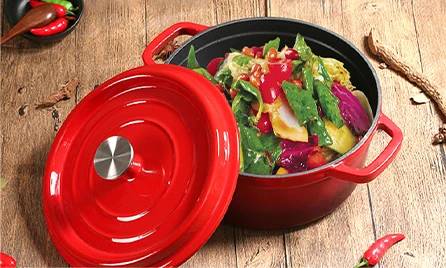
Comparing Cast Iron and Enameled Cast Iron for Cooking Performance and Durability
When it comes to cooking, the choice of cookware can make a significant difference in both preparation and the final outcome of your meals. Among the various materials available, cast iron and enameled cast iron are two popular options, each with its own unique advantages and drawbacks. Choosing between the two can be a bit of a challenge, as both have their loyal advocates. This article aims to explore the differences between cast iron and enameled cast iron, along with their respective benefits, to help you determine which is better suited for your cooking needs.
Understanding Cast Iron
Cast iron cookware has been a staple in kitchens for centuries. Its classic design and material make it a go-to for many home cooks and professional chefs alike. Traditional cast iron skillets and pots are known for their ability to retain heat, providing consistent cooking temperatures. This makes them ideal for searing meat, frying, and baking.
One of the most significant advantages of traditional cast iron cookware is its durability. With proper care, cast iron can last a lifetime—or even longer. Many people inherit beloved cast iron skillets from their grandparents, embodying years of culinary history. Moreover, cast iron is versatile; it can be used on the stovetop, in the oven, or even over an open flame.
However, cast iron requires regular seasoning, which involves applying oil to create a non-stick surface. This process helps prevent rusting and enhances the performance of the skillet. Maintenance can be a downside for some, as improper cleaning or neglect can lead to issues such as corrosion and stickiness.
Exploring Enameled Cast Iron
Enameled cast iron is a newer addition to the kitchenware family, combining the benefits of traditional cast iron with a modern twist. Enameled cast iron, such as those made by Le Creuset or Staub, features a vitreous enamel coating that prevents rust and eliminates the need for seasoning. This makes enameled cast iron much easier to maintain than its non-enameled counterpart.
One of the key benefits of enameled cast iron is its aesthetic appeal. Available in a variety of colors, enameled cookware is not only functional but can also serve as a beautiful serving piece. This means you can transition from stovetop to table without needing to transfer food to another dish.
which is better cast iron or enameled cast iron

Enameled cast iron also offers advantages in terms of acidity. Unlike traditional cast iron, which can react with acidic ingredients like tomatoes, enameled cast iron is non-reactive. This makes it a safer choice for a wider variety of recipes, including those that require long, slow cooking with acidic components.
However, the enameled coating can be prone to chipping if mishandled or subjected to sudden temperature changes. Additionally, enameled cast iron tends to be heavier and more expensive than traditional cast iron, which might be a consideration for some buyers.
Which is Better?
The choice between traditional cast iron and enameled cast iron ultimately depends on your cooking style, preferences, and budget. If you frequently cook dishes that require high heat and enjoy the process of seasoning and maintaining your cookware, traditional cast iron may be more suitable. It excels in versatility and durability, making it a favorite for many cooks who appreciate its rich history.
On the other hand, if you prioritize ease of use and aesthetic appeal, enameled cast iron might be the way to go. Its non-reactive surface opens up a broader range of culinary possibilities, while the vibrant colors can enhance your kitchen decor. Enameled cookware requires less maintenance and is more forgiving for novice cooks.
Conclusion
Both traditional cast iron and enameled cast iron have their merits, making them excellent additions to any kitchen. Ultimately, the better option depends on your personal cooking habits and what you value more in your kitchenware. If possible, consider investing in both types; traditional cast iron for its heat retention and durability, and enameled cast iron for its ease of use and stylish appearance. By understanding the strengths of each, you'll be well-equipped to make a decision that will enhance your cooking experience.
-
Season Cast Iron Perfectly with GPT-4 Turbo TipsNewsAug.01,2025
-
High Quality Cast Iron Cookware - Baixiang County Zhongda MachineryNewsAug.01,2025
-
Premium Cast Iron Pan: Durable & Perfect HeatNewsAug.01,2025
-
High Quality Kitchen Durable Black Round Cast Iron Cookware Pancake Crepe Pan-Baixiang County Zhongda Machinery Manufacturing Co., Ltd.NewsAug.01,2025
-
Cast Iron Cookware - Baixiang County Zhongda Machinery | Nonstick, Heat ResistanceNewsAug.01,2025
-
High Quality Kitchen Durable Black Round Cast Iron Cookware - Baixiang County Zhongda Machinery | Non-Stick, Heat Retention, DurableNewsJul.31,2025


